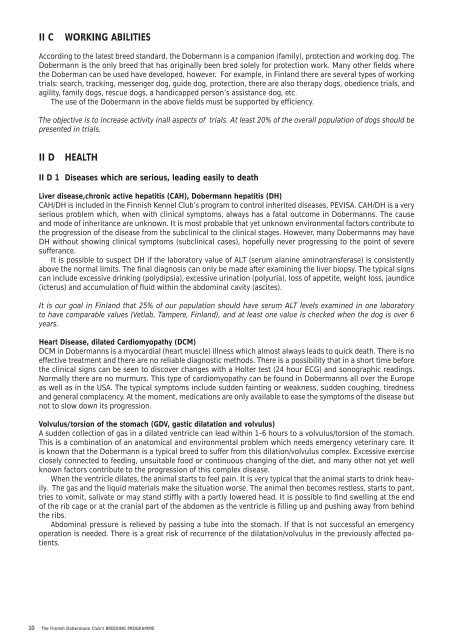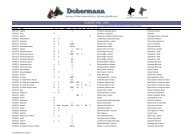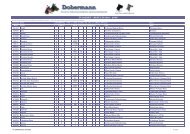Breeding Programme
Breeding Programme
Breeding Programme
You also want an ePaper? Increase the reach of your titles
YUMPU automatically turns print PDFs into web optimized ePapers that Google loves.
II C<br />
WORKING ABILITIES<br />
According to the latest breed standard, the Dobermann is a companion (family), protection and working dog. The<br />
Dobermann is the only breed that has originally been bred solely for protection work. Many other fields where<br />
the Doberman can be used have developed, however. For example, in Finland there are several types of working<br />
trials: search, tracking, messenger dog, guide dog, protection, there are also therapy dogs, obedience trials, and<br />
agility, family dogs, rescue dogs, a handicapped person’s assistance dog, etc.<br />
The use of the Dobermann in the above fields must be supported by efficiency.<br />
The objective is to increase activity inall aspects of trials. At least 20% of the overall population of dogs should be<br />
presented in trials.<br />
II D HEALTH<br />
II D 1 Diseases which are serious, leading easily to death<br />
Liver disease,chronic active hepatitis (CAH), Dobermann hepatitis (DH)<br />
CAH/DH is included in the Finnish Kennel Club’s program to control inherited diseases, PEVISA. CAH/DH is a very<br />
serious problem which, when with clinical symptoms, always has a fatal outcome in Dobermanns. The cause<br />
and mode of inheritance are unknown. It is most probable that yet unknown environmental factors contribute to<br />
the progression of the disease from the subclinical to the clinical stages. However, many Dobermanns may have<br />
DH without showing clinical symptoms (subclinical cases), hopefully never progressing to the point of severe<br />
sufferance.<br />
It is possible to suspect DH if the laboratory value of ALT (serum alanine aminotransferase) is consistently<br />
above the normal limits. The final diagnosis can only be made after examining the liver biopsy. The typical signs<br />
can include excessive drinking (polydipsia), excessive urination (polyuria), loss of appetite, weight loss, jaundice<br />
(icterus) and accumulation of fluid within the abdominal cavity (ascites).<br />
It is our goal in Finland that 25% of our population should have serum ALT levels examined in one laboratory<br />
to have comparable values (Vetlab, Tampere, Finland), and at least one value is checked when the dog is over 6<br />
years.<br />
Heart Disease, dilated Cardiomyopathy (DCM)<br />
DCM in Dobermanns is a myocardial (heart muscle) illness which almost always leads to quick death. There is no<br />
effective treatment and there are no reliable diagnostic methods. There is a possibility that in a short time before<br />
the clinical signs can be seen to discover changes with a Holter test (24 hour ECG) and sonographic readings.<br />
Normally there are no murmurs. This type of cardiomyopathy can be found in Dobermanns all over the Europe<br />
as well as in the USA. The typical symptoms include sudden fainting or weakness, sudden coughing, tiredness<br />
and general complacency. At the moment, medications are only available to ease the symptoms of the disease but<br />
not to slow down its progression.<br />
Volvulus/torsion of the stomach (GDV, gastic dilatation and volvulus)<br />
A sudden collection of gas in a dilated ventricle can lead within 1-6 hours to a volvulus/torsion of the stomach.<br />
This is a combination of an anatomical and environmental problem which needs emergency veterinary care. It<br />
is known that the Dobermann is a typical breed to suffer from this dilation/volvulus complex. Excessive exercise<br />
closely connected to feeding, unsuitable food or continuous changing of the diet, and many other not yet well<br />
known factors contribute to the progression of this complex disease.<br />
When the ventricle dilates, the animal starts to feel pain. It is very typical that the animal starts to drink heavily.<br />
The gas and the liquid materials make the situation worse. The animal then becomes restless, starts to pant,<br />
tries to vomit, salivate or may stand stiffly with a partly lowered head. It is possible to find swelling at the end<br />
of the rib cage or at the cranial part of the abdomen as the ventricle is filling up and pushing away from behind<br />
the ribs.<br />
Abdominal pressure is relieved by passing a tube into the stomach. If that is not successful an emergency<br />
operation is needed. There is a great risk of recurrence of the dilatation/volvulus in the previously affected patients.<br />
10 The Finnish Dobermann Club’s BREEDING PROGRAMME

















